INSTITUT SUPERIEUR D'ANTHROPOLOGIE
INSTITUTE OF ANTHROPOLOGY
ONLINE COURSES / COURS A DISTANCE
INSCRIPTION 2012 / Session II : Avril 2012
REGISTRATION 2012 / Term II : April 2012
VIET NAM – 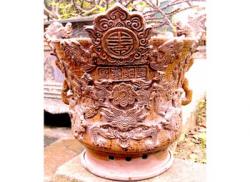 Tien Son - An ancient incense burner has been unearthed at the historical Tien Son excavation site in Hong Linh Town in Ha Tinh Province. The cylindrical ceramic incense burner is 50 cm high and 30 cm in diametre, weighing 5 kilograms. The antique piece has masterful decorations of unique and beautiful patterns, eight-petal flowers, two phoenix and dragons. It has a tiger head shaped-relief work on it as well. According to experts, the ancient incense burner dates back to the Le Dynasty.
Tien Son - An ancient incense burner has been unearthed at the historical Tien Son excavation site in Hong Linh Town in Ha Tinh Province. The cylindrical ceramic incense burner is 50 cm high and 30 cm in diametre, weighing 5 kilograms. The antique piece has masterful decorations of unique and beautiful patterns, eight-petal flowers, two phoenix and dragons. It has a tiger head shaped-relief work on it as well. According to experts, the ancient incense burner dates back to the Le Dynasty.
http://www.saigon-gpdaily.com.vn/Culture_Art/2012/2/100018/
MALAISIE – 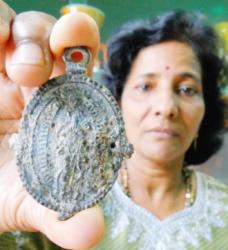 Malacca - A baby shark being prepared for lunch gave a family here a big surprise - an ancient artifact believed to be dated long before the Portuguese conquest of Malacca. It is believed to be a medallion worn by the Portuguese soldiers, presumably as a divine protection, during their conquests in this part of the world in the 16th century. One side of the medallion is a profile of a woman's head with a crown and encircled by a halo and an inscription that is unclear. The other side is a crucifix with an engraved inscription that read ANTONII. Checks with a local historian revealed the head engraving could be that of Queen Elizabeth, the consort of King Denis I of Portugal during his reign from 1271 to 1336. The medallion is 7.4cm long, 6cm wide and weighs 10g.
Malacca - A baby shark being prepared for lunch gave a family here a big surprise - an ancient artifact believed to be dated long before the Portuguese conquest of Malacca. It is believed to be a medallion worn by the Portuguese soldiers, presumably as a divine protection, during their conquests in this part of the world in the 16th century. One side of the medallion is a profile of a woman's head with a crown and encircled by a halo and an inscription that is unclear. The other side is a crucifix with an engraved inscription that read ANTONII. Checks with a local historian revealed the head engraving could be that of Queen Elizabeth, the consort of King Denis I of Portugal during his reign from 1271 to 1336. The medallion is 7.4cm long, 6cm wide and weighs 10g.
http://thestar.com.my/news/story.asp?file=/2012/2/22/nation/10773938&sec=nation
IRAK – 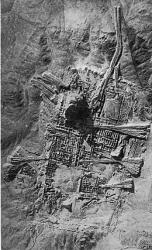 Ur - Iraqi and foreign archaeologists have uncovered a temple at the Sumerian city of Ur, which dates back to about 2500 B.C., the head of the Antiquities Department says. So far the scientists have uncovered one of the walls of the temple along with numerous graves from the same period, said Hussein Rashid. Ur is one of ancient Iraq’s most fascinating cities. It has given the world priceless treasures from the Sumerian civilization that flourished in southern Iraq. The Sumerians, whose ethnic and linguistic stock is still a mystery, invented writing and established a civil system of government in southern Iraq more than 5000 years ago. “An Italian excavation team in coordination with their Iraqi counterparts have uncovered the wall of a temple dating to 2500 B.C. at Tel Abu Tabeer in the ancient city of Ur,” said Rashid. Rashid said there were three foreign excavation teams currently working in Iraq. It is the first team of foreign archaeologists to be working in the country for more than two decades. Rashid said an American team was to arrive in Iraq to excavate ancient mounds in the southern city of Nasiriya, the capital of Dhi Qar Province where the richest and most ancient Mesopotamian ruins are found. Rashid also said another Italian group will be arriving in the country to excavate the ancient Assyrian military capital, Nimrud, in the northern Province of Nineveh.
Ur - Iraqi and foreign archaeologists have uncovered a temple at the Sumerian city of Ur, which dates back to about 2500 B.C., the head of the Antiquities Department says. So far the scientists have uncovered one of the walls of the temple along with numerous graves from the same period, said Hussein Rashid. Ur is one of ancient Iraq’s most fascinating cities. It has given the world priceless treasures from the Sumerian civilization that flourished in southern Iraq. The Sumerians, whose ethnic and linguistic stock is still a mystery, invented writing and established a civil system of government in southern Iraq more than 5000 years ago. “An Italian excavation team in coordination with their Iraqi counterparts have uncovered the wall of a temple dating to 2500 B.C. at Tel Abu Tabeer in the ancient city of Ur,” said Rashid. Rashid said there were three foreign excavation teams currently working in Iraq. It is the first team of foreign archaeologists to be working in the country for more than two decades. Rashid said an American team was to arrive in Iraq to excavate ancient mounds in the southern city of Nasiriya, the capital of Dhi Qar Province where the richest and most ancient Mesopotamian ruins are found. Rashid also said another Italian group will be arriving in the country to excavate the ancient Assyrian military capital, Nimrud, in the northern Province of Nineveh.
http://www.azzaman.com/english/index.asp?fname=news\2012-02-23\kurd.htm
IRAK – 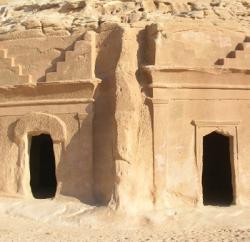 Madain - An Iraqi town wants to return to its previous status as a centre for archaeology and tourism. Madain, a town of some 7,000 inhabitants, was founded by the Parthian King Mithridates I more than 2,000 years ago. It now lies between the two main highways linking the capital with southern Iraq, as do historical sites such as the Arch of Ctesiphon and the tomb of Salman Pak one of the companions of the Prophet Mohammed.
Madain - An Iraqi town wants to return to its previous status as a centre for archaeology and tourism. Madain, a town of some 7,000 inhabitants, was founded by the Parthian King Mithridates I more than 2,000 years ago. It now lies between the two main highways linking the capital with southern Iraq, as do historical sites such as the Arch of Ctesiphon and the tomb of Salman Pak one of the companions of the Prophet Mohammed.
http://www.brecorder.com/world/middle-east/47489-madain-seeks-previous-tourism-archaeology-status.html
FRANCE - La Peute-Combe - Régis Labeaune a mis en lumière les découvertes des fouilles qu’il a entreprises sur le tracé de la LiNo, dans la Peute-Combe, découvertes qu’il qualifie d’exceptionnelles. Ces fouilles ont été réalisées en 2009 sur les territoires des deux communes : Plombières-lès- Dijon et Talant. En résumé, un habitat celte existait dans la Peute-Combe entre 500 et 450 avant notre ère (âge du fer). Puis, au cours du premier siècle de notre ère, ce sont de petits établissements agricoles qui ont été mis au jour. Et après, plus rien !
http://www.bienpublic.com/grand-dijon/2012/02/28/la-peute-combe-des-fouilles-et-une-brochure
IRLANDE – Cork - Dwellings cut into a rock face in a West Cork town have been unearthed, making it a possibly unique discovery. Volunteers from a Tús project stumbled upon pre-Famine-built houses while clearing scrubland in Skibbereen. Cork’s county archaeologist, Mary Sleeman, said she was very enthusiastic about the prospects of the site at Windmill Rock, which overlooks the town. "I have visited a lot of vernacular houses in the county and we have mud houses and stone-built houses bonded with bulls’ blood and mortar and a combination of both," she said. "And sometimes there’s been the use of rock face to form a wall but I have not seen rock-cut houses like these before — forming three sides with unusual niches cut into the walls." The rear and side walls of six rock-cut houses still survive, cut into the bedrock. The houses are all of similar dimensions, with side and back walls rising to about 1.5 metres. According to a local authority heritage unit report, "there are intriguing rock-cut features cut into the wall. The function of these features is unclear at present — some look like seats, others look like niches to support roof timbers. A more careful study is required to determine their nature and function". An archaeology survey of Cork found a lot of similar buildings dating to post-1700 and they are designated as "recorded monuments".
http://www.irishexaminer.com/ireland/pre-famine-rock-dwelling-unearthed-185139.html
FRANCE - 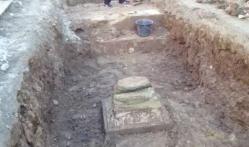 Saint-Martin de Brive - Les travaux d'archéologie préventive menés à Brive dans les pourtours de la collégiale ont permis d'identifier un pavement et une base de colonne qui pourrait correspondre à une ancienne salle capitulaire.
Saint-Martin de Brive - Les travaux d'archéologie préventive menés à Brive dans les pourtours de la collégiale ont permis d'identifier un pavement et une base de colonne qui pourrait correspondre à une ancienne salle capitulaire.
VIDEO = http://www.dailymotion.com/video/xp3ug1_saint-martin-de-brive-salle-capitulaire_news
FRANCE – Tourcoing - Les fondations d'une ferme du XVIIIe siècle ont été découvertes. En sondant le sol, les spécialistes de l'Institut national de recherches archéologiques préventives (INRAP) ont mis au jour les restes d'une ferme à l'emplacement où doit se construire le pôle commercial Promenade de Flandre. Le bâtiment aurait été détruit dans les années quatre-vingt-dix. Les dalles de l'entrée sont encore apparentes, tout comme l'emplacement de la cheminée au niveau de l'habitation principale.Une ferme du XVIe siècle devrait également se trouver sur la zone. L'équipe de spécialistes poursuit ses recherches jusqu'à vendredi.
http://www.lavoixdunord.fr/actualite/L_info_en_continu/Region/2012/02/28/article_tourcoing-les-fondations-d-une-ferme-du.shtml